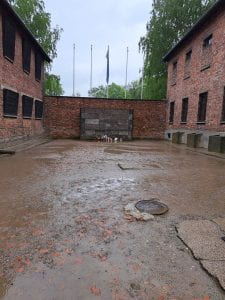Poland holds some of the deepest and darkest aspects of World War II, the most gut wrenching took place at the Auschwitz Concentration Camps. As a Polish/Hungarian Jewish woman, I felt such a deep connection and appreciation for my ability to walk through these places where my family endured so much. After the visit to the concentration camp, the group had a chance to visit Oskar Schindler’s Factory Museum, which primarily focused on the city of Krakow. This museum brought to light some truth behind the Polish innocence in the war and participation.
Throughout the course of the semester, this class has studied participation in the war and passive action that benefited the Nazi regime. Poland was occupied quickly by the Nazis and unfortunately left many endangered citizens unprotected. The Schindler Museum discusses the conflict that the Poles faced with protecting the Jews or protecting themselves. Many Poles did not stand up in defense of the Jews because their resistance threatened them and their families; they adopted a “better them than me” strategy. Even those inclined to help sometimes faced this choice. In one case, a Krakow woman had housed a Jewish man for some time until “our cleaner threatened to expose us to the police. By morning I asked him to leave the house not caring where else he went.”
Because they chose to protect themselves over the Jewish population, Poles can be held accountable for aiding in the Nazi work. In our studies we read a book discussing the mass murder of a Jewish population in the Polish town of Jedwabne by their own Polish neighbors. The Poles acted in fear of being the next victims of the Nazi regime. Families turned on each other and so did neighbors. Although there were several Poles who were participating in a resistance and helping the Jews, one cannot disregard those who participated in Nazi actions just to preserve themselves at the cost of others.




 When considering this study abroad trip, I had concerns about visiting Poland with Russia’s war against Ukraine happening right next door. I worried about my safety, and I envisioned a tense atmosphere in Poland that would reflect my worries. However, this was far from the atmosphere that I experienced in Krakow. Most Poles continue about their normal daily lives — workers tend their shops, people eat at restaurants, and young people go out to bars late into the night. No shortages were apparent. The tourism business thrives despite the war a border away. Some Ukrainian flags adorn the outside of businesses, but, as with the Ukrainian flags hanging in the United States, I wondered if these shows of support corresponded to real contributions to Ukraine’s aid. While I didn’t get to observe it myself, singers did perform one night to collect aid for Ukraine. However, I was surprised there weren’t more demonstrations specifically against Russian aggression, especially considering Poland’s own history of being occupied by Eastern aggressors.
When considering this study abroad trip, I had concerns about visiting Poland with Russia’s war against Ukraine happening right next door. I worried about my safety, and I envisioned a tense atmosphere in Poland that would reflect my worries. However, this was far from the atmosphere that I experienced in Krakow. Most Poles continue about their normal daily lives — workers tend their shops, people eat at restaurants, and young people go out to bars late into the night. No shortages were apparent. The tourism business thrives despite the war a border away. Some Ukrainian flags adorn the outside of businesses, but, as with the Ukrainian flags hanging in the United States, I wondered if these shows of support corresponded to real contributions to Ukraine’s aid. While I didn’t get to observe it myself, singers did perform one night to collect aid for Ukraine. However, I was surprised there weren’t more demonstrations specifically against Russian aggression, especially considering Poland’s own history of being occupied by Eastern aggressors. Our tour guide also called the Slavic nations “last minute masters.” By this, she meant that the Poles can mobilize quickly to counter any threat. However, I don’t think “masters” is the right word here, because it implies that the Poles succeed in repelling their enemies without prior planning. The Poles were swiftly overrun by the Germans in 1939, so hearing the tour guide speak proudly about their “last minuteness” caught me off guard. I realize there are dangers in drawing conclusions about an entire nation from one city or one tour guide, but the Poles do not seem to have taken their defeat in 1939 as a lesson in the importance of preparation.
Our tour guide also called the Slavic nations “last minute masters.” By this, she meant that the Poles can mobilize quickly to counter any threat. However, I don’t think “masters” is the right word here, because it implies that the Poles succeed in repelling their enemies without prior planning. The Poles were swiftly overrun by the Germans in 1939, so hearing the tour guide speak proudly about their “last minuteness” caught me off guard. I realize there are dangers in drawing conclusions about an entire nation from one city or one tour guide, but the Poles do not seem to have taken their defeat in 1939 as a lesson in the importance of preparation.



 nce the invasion, making them appear almost natural; the interior walls of the bunker have grown over with lichen and moss, making them an earthy green color.
nce the invasion, making them appear almost natural; the interior walls of the bunker have grown over with lichen and moss, making them an earthy green color.





















 German Cemetery
German Cemetery American Cemetery
American Cemetery
